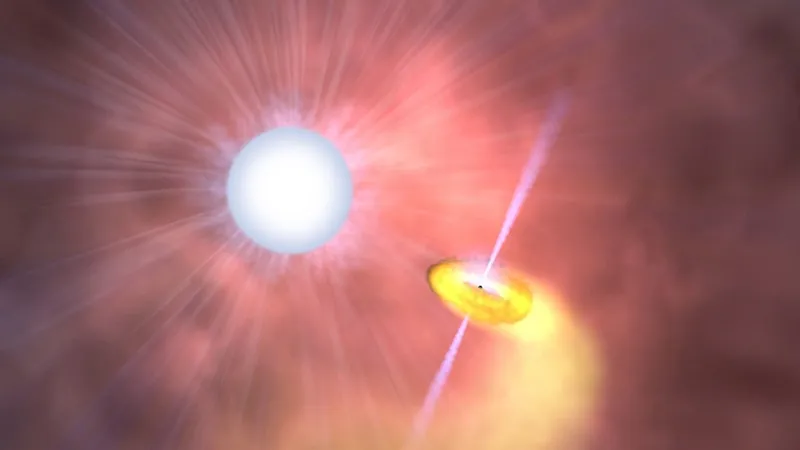
Astronomers Unveil a 'Hidden Black Hole' in Cygnus X-3 Using Advanced X-Ray Technology!
2024-11-26
Author: John Tan
Introduction
A groundbreaking study conducted by astronomers utilizing the Japanese-led X-ray Imaging and Spectroscopy Mission (XRISM) has shed light on the enigmatic binary system, Cygnus X-3, believed to harbor a 'hidden' black hole alongside a massive star known for its powerful stellar winds.
About XRISM
The XRISM, a collaboration between the Japan Aerospace Exploration Agency (JAXA) and NASA, has produced the most detailed map of the gases circulating within this cosmic system, located approximately 32,000 light-years away in the northern constellation of Cygnus, also known as the Swan.
Importance of Cygnus X-3
Cygnus X-3 is a well-studied object, having been observed by every X-ray satellite that has ever been launched, making it an essential target for new X-ray explorations.
Observational Insights
Team member Timothy Kallman, an astrophysicist at NASA's Goddard Space Flight Center, remarked, “For XRISM, Cygnus X-3 is a Goldilocks target — its brightness is 'just right' for our observations.” The proximity of the black hole and the massive Wolf-Rayet star enables them to orbit each other in less than five hours, creating a dramatic relationship where the black hole appears to be consuming material from its stellar companion.
The Role of the Wolf-Rayet Star
The massive star in question, a Wolf-Rayet star, exhibits intense stellar winds — outflows of gas moving at speeds up to 1,000 times the speed of sound — which facilitate the intricate interaction with the compact object, likely a black hole. Ralf Ballhausen, the study's lead researcher, emphasized that the unique characteristics of this massive star add a layer of intrigue to Cygnus X-3.
Technical Observations
In March 2024, XRISM observed Cygnus X-3 for an impressive 18 hours using its advanced Resolve instrument, creating a high-resolution spectrum that illustrated the complex dynamics of gases at play.
Findings
This exploration revealed how these gases generate turbulence and interact with the suspected black hole, helping to clarify their behavior in the vicinity of the compact stellar remnant.
Gas Dynamics
The researchers noted that the observed spectrum displayed peaks and valleys due to the rapid movement of gas, which undergoes 'redshift' when moving away from Earth and 'blueshift' when approaching us.
Additional Insights
Fascinatingly, the majority of gas in Cygnus X-3 is blueshifted, moving toward our planet at an astounding speed of around 930,000 miles per hour (1.5 million kilometers per hour).
Significance of the Study
This cutting-edge data collection holds significance beyond just mapping gases. The study demonstrated that there is substantial absorption of X-ray energies emitted by the compact object, as determined by the researchers analyzing ionized iron features within the spectrum.
Future Exploration
Brian Williams, the XRISM project scientist, stated, 'A key to acquiring this detail was XRISM's ability to monitor the system over the span of multiple orbits. This discovery opens up further avenues for exploration, and ultimately, we aspire to confirm if the compact object in Cygnus X-3 is indeed a black hole.'
Conclusion
This exciting research will soon be published in the Astrophysical Journal, paving the way for deeper understanding of not only Cygnus X-3 but also similar celestial phenomena across the universe. Get ready, space enthusiasts, as the mysteries of the cosmos continue to unfold!



 Brasil (PT)
Brasil (PT)
 Canada (EN)
Canada (EN)
 Chile (ES)
Chile (ES)
 España (ES)
España (ES)
 France (FR)
France (FR)
 Hong Kong (EN)
Hong Kong (EN)
 Italia (IT)
Italia (IT)
 日本 (JA)
日本 (JA)
 Magyarország (HU)
Magyarország (HU)
 Norge (NO)
Norge (NO)
 Polska (PL)
Polska (PL)
 Schweiz (DE)
Schweiz (DE)
 Singapore (EN)
Singapore (EN)
 Sverige (SV)
Sverige (SV)
 Suomi (FI)
Suomi (FI)
 Türkiye (TR)
Türkiye (TR)